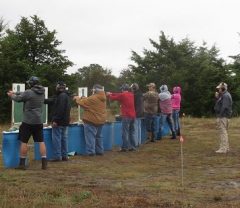There’s good news, and bad news.
The good news is that, yes, you can use a .22 for the Proficiency. When this article was originally written, that was not true, but now it is.
The bad news, however, has to do with whether or not you should take advantage of that. Some people, including some I respect, think this would be a good change. I disagree, but not for the expected reason. I have gone on record before, suggesting that the .22 should not be so easily dismissed as a defensive weapon, especially if it has a long barrel and a high-capacity magazine. Even the tiny Baretta Bobcat, with its 6-round magazine is better than nothing, but not much better. A target pistol, like the Ruger Mark IV, would allow you to put 10 rounds in a home invader in a matter of seconds, which would likely make him rethink his career choices. However, unless you took a head shot, that would slow him down, but might not stop him immediately. Keep in mind that that home invader, upon seeing the pistol, could get to you from across a large room in under 2 seconds (the well-documented Tueller Paradigm). If he has a knife, putting him in the hospital won’t save your life. The .22 only works if the invader doesn’t rush you.
However, I digress. My objection is not so much in using a .22, but in leading a person to think they know how to handle a firearm. There is a world of difference between the .22 and calibers like 9mm, 10mm, .40, .45, .38 Special, or the legendary .357 Magnum. Learning to shoot only a .22 is like riding a tricycle and thinking you can also ride a Harley. True, the .22 has killed many people. It is often the choice of hit men, but they surprise their victims, take head shots, or both, and the noise factor is important.
I often let beginners fire a few rounds from a .22 first, so they can get a sense of it, before we move on to something larger. The skills learned in handling a larger caliber gun will easily translate back to a smaller one, but the reverse is not necessarily true.
Whatever the point might be in allowing the .22 for the LTC Proficiency, it can’t be making it easier to get the license. It is already easy enough for someone with a week’s experience. The result would be people scoring 245 instead of 210 (175 is passing), and thinking they are now armed.
Col. Jeff Cooper once said, “Owning a handgun doesn’t make you armed any more than owning a guitar makes you a musician.”
